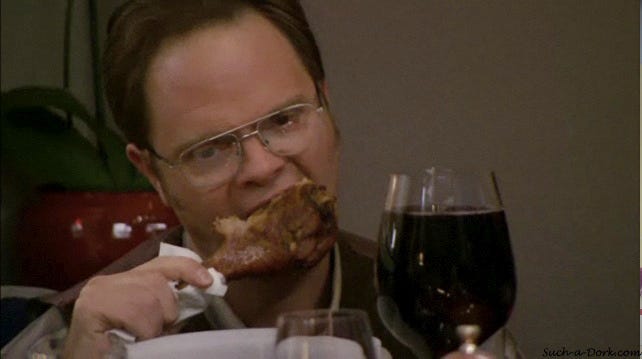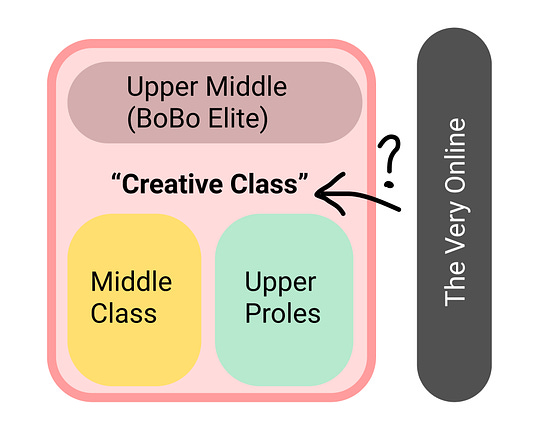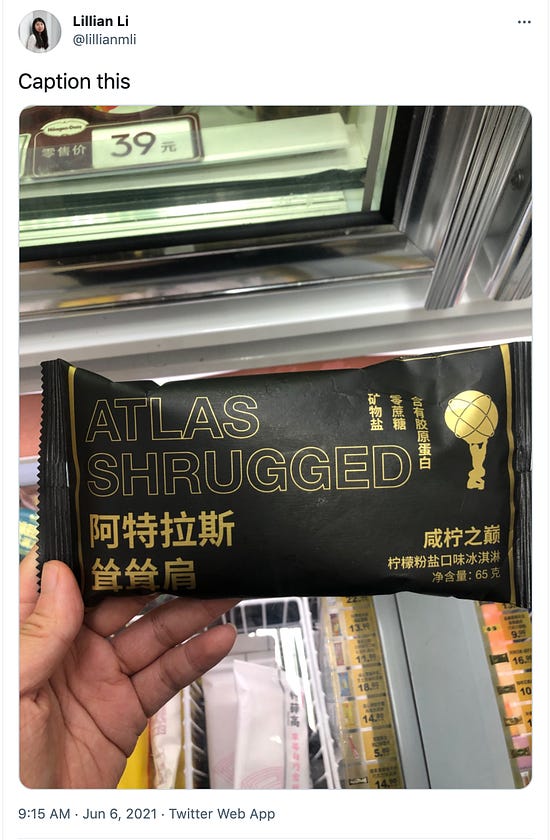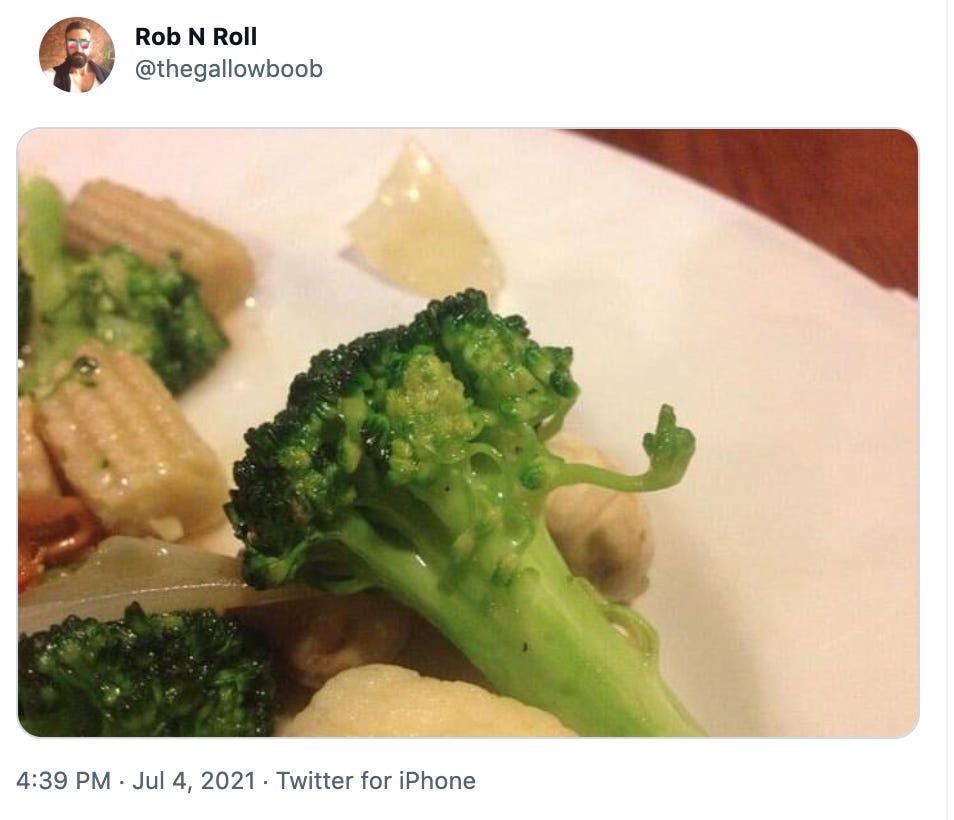Michael, Dwight and Andy: the Three Aesthetics of the Creative Class
Michael, Dwight and Andy: the Three Aesthetics of the Creative ClassDancoland Season 3, Episode 18
Six months ago I proposed The Michael Scott Theory of Social Class, which says: "The higher you ascend the ladder of the Educated Gentry class, the more you become Michael Scott." The Michael Scott Theory of Social Class delineated the three-tier structure of the modern workplace and of the American class system. Those on the top and on the bottom both experience the world as it literally is, but those in the middle - Michael, Dwight and Andy in the show; or, the educated gentry class - live in their own reality they've constructed, with farcical yet familiar consequences. Now it's time for part two. We're going to explore the educated gentry in more depth, and parse this group of people - which we'll call the Creative Class - into three separate cultures, each with their own terroir and aesthetic. And we'll introduce a new rule: If you are a member of the Creative Class, then your aesthetic is either Michael, Dwight or Andy. Background: the origins of the Creative Class Our American class system continually defies simplification; but if pressed, you can trace our current creative class back to four common ancestors. The 1960s hierarchy had WASPs on the top, a growing suburban middle class, and a large multifaceted proletariat. One extra group who did not fit neatly into this class ranking were the bohemians, who commanded significant cultural capital despite having no money. These four groups - WASPs, the Middle Class, Proles, and Bohemians - are our four starting materials. In the 90s, the WASPs and the Bohemians, historically opposites of one another, peacefully merged. In Bobos in Paradise, David Brooks coined a lovely term, "BoBos" (Bourgeois Bohemians) to describe this new ruling class of the Interesting Individual. The BoBos merged the free-spirit, individualistic romance of the bohemians with the pragmatic capitalism of the bourgeois, into a new social aesthetic that demanded the best of both. "Being Interesting" (and healthy, green, worldly, and progressive) was both good social capital and good business. This merger between the Bohemians and the Bourgeois wasn't a coincidence - it was a savvy adaptation to the information age. The WASPs were always a strange ruling class, relative to the elites of other countries, because they were so dull. They hated new ideas and creative expression, and their food was terrible. Meanwhile, the now-middle-aged hippies realized that they liked money, and that they were good at making it. The hippies knew how to tell you that you were unique and special; they inevitably figured out how to sell you that aesthetic. The merger really worked. The BoBo vibe eventually just became mainstream culture. We grew into the information age, where success and status isn't signalled by what suit you wear and where you're a country club member: it's about how interesting you are, what experiences you've cultivated, how personally branded you are, and how virtuous your consumption. As this happened, everyone - above a certain socioeconomic line, anyway - made a lot of money. A new job category, coined Creative Class jobs by Richard Florida, spanned the wide range of BoBo industries that all have to do with "making new forms of things" - not just art and culture but also business models, sales and marketing, product management, finance, the law, and all kinds of other vocations that demand creative output. This new emerging mega-category of well-paying employment - not to mention twenty years of falling interest rates - meant this new Creative Class had money to spend on their new identities, and plenty of loft spaces, kitchen remodels, high-performance sports gear, and organic food to consume. And as the category grew, it welcomed an influx of people out of three different backgrounds: The first group of people were the original BoBos, whose parents were the Upper Middle bourgeois WASPs. The second group of people came from the familiar Middle Class. Had the Creative Class remained restricted to those two groups, them it would never have gone truly mainstream as it has. It's the third group of Creatives - the Upper Proles - who took the Creative Class by storm, and currently threaten to unseat the Middle Class in both status and wealth. All three groups currently exist in a kind of artificially constructed reality. Their day to day lives all take place in the same ephemeral plane, populated with AirSpace, Trader Joes, and Pelotons. But they're each playing their own game, and putting on their own distinct aesthetic performance. One group is playing Michael Scott; one group is playing Dwight Schrute, and one group is playing Andy Bernard. Let's take a look: Michael Scott: The Middle Class. The middle class aesthetic may have evolved superficially over the past forty to sixty years, but its purpose has remained the same: the anxious, yearning need to be taken seriously. The middle classes' primary differentiating characteristic, more than their incomes or addresses, is their earnestness and insecurity. The middle class has been perpetually gripped by "Status Panic", as C. Wright Mills wrote 70 years ago, and through today they're still preoccupied with putting on the same show. They need you to know that they're doing it right. The Middle Class, both then and now, is always reaching and "play-acting" the type - or, at least, what they think is the type - of those above them. They subscribe to the New Yorker, and pretend to roll their eyes (but secretly delight in) their umlaut spelling of words like "naïve". (Which is actually a diaeresis, not an umlaut, but they don't know that.) When offering wine to guests, they might have said "Let's get out the crystal" (upper class people do not say that; they just say 'glasses'). They celebrate open-concept renovations as great for entertaining, but fail to recognize that the best spaces for throwing parties are actually houses with many divided rooms. This is the group of people that keep the advertising industry in business, for they are both highly anxious and impressionable, but also convinced that ads don't work on them. The same people who were keen for gourmet or designer offerings a generation ago are now equally susceptible to sustainable, lightweight, or professional. They have a fatal weakness for anything with "carbon" in the name: carbon-fibre bicycles, carbon-steel kitchen knives, carbon-neutral ski resorts. These are the Michael Scotts. Although Michael's character in the show is not contemporary middle class (he never went to college, for instance), he's continuously putting on a middle class show, and that's what matters. He is absolutely earnest, he is good hearted, and his entire life is an arbitrary fabrication that's reinforced through praise. Michael would have made a great PhD student, or a great weekend warrior triathlete. Michael's best middle-class characteristic is that he's snobby, in an endearing sort of way. He is always worried, in the back of his mind, that his authentic tastes and preferences might be inadequate, or that his office parties might be uninspiring. Yet at the same time, he's inclusive: all he really wants is for everyone to laugh together. Michael is a salesman, and he deeply believes that you can achieve unity through persistent effort and affability. As Paul Fussell put it in his 1983 book Class: A Guide through the American Status System: A final stigma of the middle class, an emanation of its social insecurity, is its habit of laughing at its own jests. Not entirely certain what social effect he's transmitting, and yet obliged, by his role as "salesman", to promote goodwill and optimism, your middle-class man serves as his own enraptured audience. Sometimes, after uttering some would-be clever formulation in public, he will look all around to gauge the response of the audience. Favourable, he desperately hopes. The only detail that differs between Fussell's description and Michael Scott is that Michael's punchline would've inevitably been "That's what she said!" The middle class aesthetic hasn't changed much since 1983, even as the information age and the rise of the Creative Classes has shifted status indicators away from material prosperity and towards being interesting. The performance is still the same: I'm doing it right. Take me seriously. The performance has always been rooted in status anxiety, and within the current Creative Class setting, it has taken on a new urgency. For the Middle Classes have new competition: Dwight Schrute: The Upper Proles It's clear who "won" the Creative Class: the Upper Proles did. They walked right in, made themselves at home, and were immediately good at it. Unlike the Middle Class, whose core aesthetic has persisted for decades, the Upper Proletariat would be unrecognizable to Paul Fussell or other class observers from older generations. Whereas the upper proles used to hew to a "working class folks but with savings" stereotype, these people are trendy. They know their wine, and have genuinely well-developed palates. They know which food trucks are the authentic ones, and live in aggressively outfitted townhouses in up-and-coming (but already expensive) neighbourhoods. They're good at Instagram. But they're still definitely Proles. One giveaway is how much they love brands. Certainly different brands than in previous generations - their brand taste has appreciated along with their disposable income - but their enthusiasm for brands in general is a signature trait. These are people who want to show, "I am winning", and the way they do it is by affiliating themselves with brands that are also winning. They're the adults who wear Supreme, and their dogs have Gucci collars. The signature Creative Class Upper Prole car is the Mercedes CLA-250. One aesthetic choice worth mentioning in particular is tattoos. Tattoos used to be a reliably prole indicator - no one middle class or above would ever have one. Now tattoos are cool and sophisticated - sometimes. It's still a prole indicator; now the difference between whether tattoos signal working-class or trendy is simply measured by how much you spent on the ink. The people who can pull off full-sleeve tattoos (representing dozens of hours, and well over a thousand dollars of investment) and provide for generous skin care afterwards? Those are your new upper proles. The Upper Proles have none of the status panic or insecurity of the middle class. It's not that they are free of anxiety altogether - they're probably pretty leveraged, and they're conscious about the appearance of their craft; so they seek recognition from others of the high standards that they've achieved. But they aren't anxious snobs; they're more straightforwardly proud. They enjoy things very literally. They like winning. They are the Dwight Schrutes. The Dwights of the world invaded the Creative Class like barbarians, and found that they were good at it. Like the BoBo elite, they intuitively understood that the personal branding and virtuous consumption industries were money-printing machines for anyone who wasn't embarrassed to make it their trade. This makes a lot of sense - the Upper Proles have always been craftsmen, the total opposite of middle class managers. Here's Fussell: High proles are quite smart, or at least shrewd. Because often their work is not closely supervised, they have a pride and a conviction of independence, and they feel some contempt for those who have not made it as far as they have. Today's Upper Prole Creative Class workers likely grew up with parents who practiced skilled trades, rather than white collar work; and they've inherited that sense of craft pride. Dwight is unabashedly proud of his various crafts, both in the office and especially on the farm, and he loves to parade around artifacts and trophies of his various conquests. Here's Fussell again, on how to identify upper proles by looking at their wallet: The High-Prole wallet always bulges, not just with snaps of wife, children, and grandchildren to exhibit when the bearer grows maudlin, but with sentimental paper memorabilia like important sports-ticket stubs and letters and other documents which can be whipped out to "prove" things. The definitive High-Prole wallet has a wide rubber band around it. There's nothing Dwight enjoys more than proving things, and the more on his turf, the better. The Upper Proles, at the end of the day, have the simplest show to put on: they have to demonstrate, "I'm a winner. Here is my evidence." And why not? They are winning. They have the most to show for their effort, and the fewest hangups. Their main frustration is also straightforward: that those above them (particularly the Middle Class) don't recognize their achievements as legitimate. But the proles are the one group of the three who actually have self-confidence; instead of reconsidering, they're simply doubled down on their place in the world. At this point, the Upper Proles are closing the status gap with the Middle Class, and have all of the momentum in their favour. Andy Bernard: the Upper Middles As with the Upper Proles, the Upper Middle class would also appear strange to Fussell if he came and looked for them today - but for the opposite reason. While the Upper Proles assertively took their place as the new, successful neighbours on the block, the Upper Middles did the opposite. They camouflaged themselves. The most interesting thing about the BoBo merger is that the WASPs got everything they wanted, but on one condition, which was sacrificing their once-ruling aesthetic. Outside of a few archaic pockets on the east coast, being visibly preppy no longer signals status, or gets you job offers, or confers any real advantage at all. You mostly get laughed at. Privilege isn't something you can lazily express through credentials and collars anymore: you have to wrap it in experience now. This left behind an interesting group of people: the offspring of the elite, now adults, who have inherited a staggering advantage from the fortunate circumstances of their upbringing, but do not advertise it - except for in code, when they're among one another. They are not necessarily wealthy themselves (plenty of WASP families have run out of money), but they do have first-degree connections to real capital, power and fame. Many of them work in the same creative class jobs, across the same open floor plan desks, as their Middle and Upper Prole colleagues - but there's a good chance that they've flown private before, or that they have a genuinely powerful person's real contact info in their phone, for some random reason. The way you can identify these people in the wild, as with the other groups, is by what performance they're putting on. While the middles' performance pleads, "Take me seriously", and the Upper Proles say, "I'm a winner", the Upper Middles' are always trying to communicate: "I am at ease." Andy Bernard tries so, so hard to do this. He's just bad at it. The importance of being at ease cannot be stressed enough: it is the mark of authority among the contemporary upper-middle class. They can slip into any situation, and be comfortable. This is a learned skill. It is hard to fake, unless you have a lot of experience; and that experience is how the upper middle class quietly communicates and creates advantage for one another. The tragedy of Andy Bernard is that he knows this; he's just utterly failed to make it work for him. Clearly, his plan coming out of Cornell was not to work a regional paper company branch, for someone like Michael, in competition with someone like Dwight. From his first day in Scranton after the branch merger, Andy is determined to establish mastery and ease in his new environment ("I'll be the number-two guy here in Scranton in six weeks. How? Name repetition, personality mirroring, and never breaking off a handshake.") But unlike in Stamford, he's uncomfortable in blue-collar Scranton and repeatedly fails to camouflage himself into his new environment, or find anyone else like him where his upper-middle class upbringing and skillset actually carries any social capital. Instead he becomes a laughingstock, and succumbs to his deep-seated WASP self-hatred and its resulting anger-management issues. The upper middles are like the upper proles in that they are at least running the right race (unlike the middles, always imitating someone else). And their main frustration is similar: nothing is ever enough. But the reason why is different - the upper middles know people who are really successful. They dread their college reunions the most. No matter what, along every possible dimension, they always have some former classmate who’s 10x as impressive, and who's nice about it. That’s why the upper middles, more than any other group, succumb to envy. Not only over major achievements, but even more so over tiny things. They feel so small compared to their class peers that small frustrations and meaningless interpersonal conflicts drive them crazy. So they’re quick to make villains out of those around them in order to rationalize their self-disappointment, as Andy does before mellowing out in later seasons. Aesthetics In Competitive Conversation To recap, we have three groups of people with distinct aesthetics here. Their aesthetic reflects what performance they’re putting on: how they present themselves to their peers, and how to they show off and jockey for status: Dwights convey, through their performance: I am winning. Michaels convey, through their performance: I am serious. Andys convey, through their performance: I am at ease. These performative aesthetics aren't really a choice. They are rooted in our personalities, and we learn them in childhood and adolescence. We watch our parents interact with each other and their friends, and then practice over and over again with our own peers as we grow up. It becomes a skill set we know cold, from practicing it 1,000 times over, and as we reach adulthood, we're ready to put it to work in competitive conversation. The essence of competitive conversation is that when you're trying to signal that you are a certain thing or that you have a certain quality, if you have to come out and say it directly, then you're definitively not that thing. (If you tell people, "I am popular!", you're not.) You have to show, not tell. Your conversational aesthetic - in other words, how you present yourself - is how you go about showing it. The way this happens naturally in conversation is a kind of world-building exercise. Your performance is really an exercise in establishing assorted conversational artifacts - facts, ideas, topics, and talking points - that provide evidence and support for whatever it is you're trying to show. But the three groups are putting on very different performances, and those performances mean filling up the conversation with different kinds of things: The upper proles, in order to show I am winning, fill the conversation with trivia. "Trivia" doesn't necessarily mean like movie trivia (although it could be), it generally means "publicly available information whose purpose is to frame the inevitable conclusion of how much I'm winning." Day trading (which the Upper Proles have embraced with zeal) is a great source of fodder for these kinds of conversations: "You see Facebook's at 350? I was in at 250 but sold at 280. Aaah, too bad, shoulda kept my diamond hands!” Same with fantasy sports, which along with day trading, is hits that powerful combo of "public spectacle, but the story's about me here." Pop culture references are routinely called upon in Upper Prole conversation, as the contemporary version of ticket stubs and receipts that their owners whip out to "prove" something. The middles, in order to show I am serious, fill the conversation with concepts. They try hard to signal worldliness and sophistication here, and so they're greatly sensitive to the intellectual level of the conversation: they want to talk about issues. The whole concept of "talking points" exists for the middle class, as does the Talk of the Town section of the New Yorker. Remember that this is a group where success is measured through detachment from reality: reality is tragic and regrettable, and deliberate detachment from that reality is therefore virtuous. 60 years ago, "reality" meant dirty dangerous cities, so the middle class detached themselves to the burbs; now, reality means car-dependent wasteland suburbs, and so the reverse migration is virtuous. Or perhaps reality means rising diabetes prevalence, which makes your Peloton virtuous. So in order to show that you're doing it right, the way you frame it is by talking about everything that's tragic in the world, and then that fills up the whole conversation. In contrast to the middle class, the upper middles (in order to show I am at ease) fill the conversation mostly with gossip. But not just ordinary gossip - everyone does that - it has to be high-value information. So that means either scandalous information, powerful people, or ideally both. Why? Because, in order to demonstrate you're at ease, you have to prove it by dropping hints that, in fact, you actually know the secret context that no one else does. Unlike the middle class, who want to play-act an "I'm sophisticated" show but without any raw material, the upper middles (who actually have some) stick to talking about real, tangible things; like who's having affairs. To give a through-line example: when the conversation turns to real estate, the upper proles talk about prices ("That house sold for a million dollars! This one for 1.1! That one over there is listed for 800, we'll see..."), the middles talk about housing demographics and social issues ("Well, if things keep going the way they're going, there won't be enough young families to support two school districts. And we keep getting less diverse!"). The upper middles talk about renovating. Whichever of these groups you're in, you've surely felt the difference between a group of people making conversation all of one social class, versus when it's mixed. When the group has one homogenous aesthetic, the conversation flows a lot more freely and it takes less effort: everyone is validating each other. What's more interesting is when you have a heterogenous conversation, with competing aesthetics and signals. You can listen, and feel the tension when different groups jockey for position as they try to fill the conversational space with their competing artifacts. The upper proles and the upper middles both get annoyed and bummed out by the middles' insistence on filling the conversation with concepts; conversely, the middles feel threatened by the upper proles' trivia dumps (because it feels so crass, and because the trivia feels so 'cheap'). The upper middles and upper proles often get along great; although usually one of them recognizes the differential. The upper middles have the trickiest job here; fortunately for them, they've built a skill set for this. If they're the only one of their kind in a conversation, they just camouflage themselves and adapt to whoever aesthetic is the majority. But if they identify another of their kind in the group, they have a tricky conversational manoeuvre to pull off. They have to subtly establish themselves (through proprietary information) without giving up their disguise; if done correctly, only the other upper middle will recognize what has taken place. It takes a lot of practice to do this well. If they miss and blow their cover, they vibe as Andy Bernard, which is a full disaster. The end of Michael, Dwight and Andy? So there you have it: the three aesthetics of the creative class. Some people are playing Dwight, some people are playing Michael, and some people are playing Andy. As tidy as this characterization might be, it won't last. The creative aesthetic is already getting transformed again, through a peaceful merger just like with the BoBos. There's a new aesthetic in town with outsize influence: Very Online people. The Online have been around for a long time; message board culture is decades old. Fifteen years ago, the Online were the true bohemians: they had truly built their own cultural world at the new electronic frontier, and they were really free. If we place the moment of peak Online Bohemia somewhere around 2005, that corresponds more or less exactly with the moment where the BoBos' rise began to plateau. We know what happens next, both from the benefit of recent memory and also through explicit pattern recognition. The Online-BoBo merger is unfolding in essentially the same way as the Bourgeois and the Bohemians joined forces: these two groups of people, until recently complete opposites of each other, realized that maybe the other side had something figured out that they actually wanted. It's clear what the BoBos envied in online culture: the freedom and the cultural vitality. BoBo culture can be just as stifling as the WASPs was, and these new frontiers like Tumblr, Reddit and Twitter were exhilarating. In the reverse direction, the Online realized that they had one of the most valuable skills of the maturing internet, and they could get paid for it. Not always a lot, but the jobs they could get often commanded old but still broadly recognized prestige, like in Media. And so, now we have this new class of people that are definitively neither the BoBos nor the original online: their aesthetic is irony, and their heroes are Chapo Trap House and The Go Off Kings. Note carefully, though, how closely related Irony and Being At Ease are to one another, as far as performances go. The Upper Middles always find a way to come out on top. The Chapo guys were Ivy League, after all. The internet did something even more consequential, though, especially over the long term. It's a new forum where people can learn and more importantly practice their aesthetic presentation. This is a huge deal. You could even make the case that it's the biggest democratizing characteristic of the internet, maybe even more than democratization of opportunity to be productive - it's democratized opportunity to learn and rehearse popular aesthetic. And that - really, maybe - could be the end of Michael, Dwight and Andy. As the internet becomes not only where we draw our cultural and aesthetic cues from, but more importantly where we go practice them and rehearse them throughout our adolescence, our emerging aesthetic as adults will have a lot less to do with our parents and our inherited social standing, and a lot more to do with where we happened to have spent time on the internet frontier growing up. So it could be that we're in the twilight years of the Michael, Dwight and Andy Creative Class. But they're not done yet. So next time you're in a Creative Class conversation, and you can sense a little competition in the air, go look for who's tactfully filling up the conversation with trivia, who's filling it with talking points, and which two people, beneath their disguises, are carefully dropping in proprietary information. And don't forget to have some fun with it. Permalink to this post is here: Michael, Dwight and Andy: the Three Aesthetics of the Creative Class | alexdanco.com For this week’s Tweet Caption Contest: Your winning submission from two episodes ago: “Government-run innovation hubs.” -Mike, Whitehorse YT. Congrats Mike! Your current finalists: “Enjoy the Galt-Free Pleasure!” -Ari, Westfield NJ “Special-made Kind Bars from the Founders Fund microkitchen” -Not Zach Weinberg “45 grams of Rearden Protein” - Liz And finally, this week’s Tweet, for your submissions: You can submit your caption, and vote on last issue’s tweet, here. Have a great week, Alex If you liked this post from Alex Danco's Newsletter, why not share it? |
Older messages
Dancoland, Part One
Monday, August 9, 2021
Are you ready? Ok, let's begin. One night, a young man who we'll call Student went to sleep and fell into a strange dream. Student: Huh, where am I? I don't recognize this place. In front
Dancoland, Part 2: Just-So Stories
Monday, August 9, 2021
Welcome back to Dancoland. If you missed part one last week, read that first. Teacher: Ok, let's examine some of those things you told me about your village. I'd love to see what assumptions
Dancoland, Part 3: Thinking in Layers
Monday, August 9, 2021
Welcome back to Dancoland. If you aren't caught up, head here to start at the beginning. Last week, we'd learned how different systems can find their own steady states, and how order emerges
You Might Also Like
3-2-1: On the secret to self-control, how to live longer, and what holds people back
Thursday, February 27, 2025
“The most wisdom per word of any newsletter on the web.” 3-2-1: On the secret to self-control, how to live longer, and what holds people back read on JAMESCLEAR.COM | FEBRUARY 27, 2025 Happy 3-2-1
10 Predictions for the 2020s: Midterm report card
Thursday, February 27, 2025
In December of 2019, which feels like quite a lifetime ago, I posted ten predictions about themes I thought would be important in the 2020s. In the immediate weeks after I wrote this post, it started
Ahrefs’ Digest #220: Hidden dangers of programmatic SEO, Anthropic’s SEO strategy, and more
Thursday, February 27, 2025
Welcome to a new edition of the Ahrefs' Digest. Here's our meme of the week: — Quick search marketing news Google Business Profile now explains why your verification fails. Google launches a
58% of B2B Buyers Won't Consider You.
Thursday, February 27, 2025
Here's why, and how to fix it. ͏ ͏ ͏ ͏ ͏ ͏ ͏ ͏ ͏ ͏ ͏ ͏ ͏ ͏ ͏ ͏ ͏ ͏ ͏ ͏ ͏ ͏ ͏ ͏ ͏ ͏ ͏ ͏ ͏ ͏ ͏ ͏ ͏ ͏ ͏ ͏ ͏ ͏ ͏ ͏ ͏ ͏ ͏ ͏ ͏ ͏ ͏ ͏ ͏ ͏ ͏ ͏ ͏ ͏ ͏ ͏ ͏ ͏ ͏ ͏ ͏ ͏ ͏ ͏ ͏ ͏ ͏ ͏ ͏ ͏ ͏ ͏ ͏ ͏ ͏ ͏ ͏ ͏ ͏ ͏ ͏ ͏ ͏
Teleportation, AI Innovation, and Outgrowing 'Good Enough'
Thursday, February 27, 2025
Oxford scientists have achieved quantum teleportation of logic gates, AI advances include France's €109B investment, Unitree's eerily smooth robotic movements, and DeepMind's Veo2 video
🧙♂️ Quick question
Thursday, February 27, 2025
Virtual dry-run of my event ͏ ͏ ͏ ͏ ͏ ͏ ͏ ͏ ͏ ͏ ͏ ͏ ͏ ͏ ͏ ͏ ͏ ͏ ͏ ͏ ͏ ͏ ͏ ͏ ͏ ͏ ͏ ͏ ͏ ͏ ͏ ͏ ͏ ͏ ͏ ͏ ͏ ͏ ͏ ͏ ͏ ͏ ͏ ͏ ͏ ͏ ͏ ͏ ͏ ͏ ͏ ͏ ͏ ͏ ͏ ͏ ͏ ͏ ͏ ͏ ͏ ͏ ͏ ͏ ͏ ͏ ͏ ͏ ͏ ͏ ͏ ͏ ͏ ͏ ͏ ͏ ͏ ͏ ͏ ͏ ͏ ͏ ͏ ͏ ͏ ͏ ͏
A Classical Way to Save the Whales
Thursday, February 27, 2025
But what song, we don't know.
I'm investing in early stage AI startups
Thursday, February 27, 2025
Hi all, I'm investing in early stage AI startups. If you know someone who's looking for easy-to-fit-in checks from helpful founders (happy to provide references) I'd love to chat. Trevor
🧙♂️ [NEW] 7 Paid Sponsorship Opportunities
Thursday, February 27, 2025
Plus secret research on La-Z-Boy, Android, and OSEA Malibu ͏ ͏ ͏ ͏ ͏ ͏ ͏ ͏ ͏ ͏ ͏ ͏ ͏ ͏ ͏ ͏ ͏ ͏ ͏ ͏ ͏ ͏ ͏ ͏ ͏ ͏ ͏ ͏ ͏ ͏ ͏ ͏ ͏ ͏ ͏ ͏ ͏ ͏ ͏ ͏ ͏ ͏ ͏ ͏ ͏ ͏ ͏ ͏ ͏ ͏ ͏ ͏ ͏ ͏ ͏ ͏ ͏ ͏ ͏ ͏ ͏ ͏ ͏ ͏ ͏ ͏ ͏ ͏ ͏ ͏ ͏
• Relax with a Great Book • Book Deals • Free • KU • Paperback •
Thursday, February 27, 2025
Reading Deals Here! Fiction and Non-fiction Book Deals for You! ContentMo's Books Newsletter









